- Clone
- 3H5 (See other available formats)
- Regulatory Status
- RUO
- Other Names
- B7-1, B7, BB1, Ly-53
- Isotype
- Mouse IgG1, κ
- Ave. Rating
- Submit a Review
- Product Citations
- publications

-

LPS-stimulated LOU rat splenocytes (3 days) were stained with CD80 (clone 3H5) PE (filled histogram) or mouse IgG1, κ PE isotype control (open histogram).
| Cat # | Size | Price | Quantity Check Availability | Save | ||
|---|---|---|---|---|---|---|
| 200205 | 50 µg | 110 CHF | ||||
CD80 is a 60 kD member of the immunoglobulin superfamily also known as B7-1, B7, and BB1. It is expressed on antigen presenting cells and activated T and B cells, and is a ligand for CD28 and CD152 (CTLA-4). CD80/CD28 interactions are important for T and B cell co-stimulation, while CD80/CD152 lead to the inhibition of T cell responses. The 3H5 antibody can block the co-stimulatory activity of CD80.
Product DetailsProduct Details
- Verified Reactivity
- Rat
- Antibody Type
- Monoclonal
- Host Species
- Mouse
- Immunogen
- HTLV-1-transformed Lewis-S1 rat T cell line
- Formulation
- Phosphate-buffered solution, pH 7.2, containing 0.09% sodium azide.
- Preparation
- The antibody was purified by affinity chromatography, and conjugated with PE under optimal conditions.
- Concentration
- 0.2 mg/ml
- Storage & Handling
- The antibody solution should be stored undiluted between 2°C and 8°C, and protected from prolonged exposure to light. Do not freeze.
- Application
-
FC - Quality tested
- Recommended Usage
-
Each lot of this antibody is quality control tested by immunofluorescent staining with flow cytometric analysis. For flow cytometric staining, the suggested use of this reagent is ≤0.25 µg per million cells in 100 µl volume. It is recommended that the reagent be titrated for optimal performance for each application.
- Excitation Laser
-
Blue Laser (488 nm)
Green Laser (532 nm)/Yellow-Green Laser (561 nm)
- Application Notes
-
Additional reported applications (for the relevant formats) include: immunoprecipitation1-3, blocking of ligand binding1-3, and immunohistochemical staining3 of acetone-fixed frozen sections. The LEAF™ purified antibody (Endotoxin <0.1 EU/μg, Azide-Free, 0.2 μm filtered) is recommended for functional assays (Cat. No. 200208).
-
Application References
(PubMed link indicates BioLegend citation) -
- Maeda, K., et al. 1997. Int. Immunol. 9:993. (IP, Block)
- Bluestone, J.A., 1995. Immunity 2:555. (IP, Block)
- Damoiseaux, J.G., et al. 1998. J. Leuk. Biol. 64:803. (IP, Block, IHC)
- Ho, CH., et al. 2007. J. Virol. 81:4837. PubMed
- Ho, C., et al. 2009. Carcinogenesis 30:1443. PubMed
- Tracey Q, et al. 2012. PLoS One. 7:e42662. PubMed.
- Product Citations
-
- RRID
-
AB_2260182 (BioLegend Cat. No. 200205)
Antigen Details
- Structure
- Ig superfamily, 60 kD
- Distribution
-
Antigen presenting cells, activated B cells and T cells
- Function
- T and B cell costimulation
- Ligand/Receptor
- CD28, CD152 (CTLA-4)
- Cell Type
- Antigen-presenting cells, B cells, T cells
- Biology Area
- Cell Biology, Costimulatory Molecules, Immunology, Neuroscience, Neuroscience Cell Markers
- Molecular Family
- CD Molecules, Immune Checkpoint Receptors
- Antigen References
-
1. Barclay, A.N. et al. 1997. The Leukocyte Antigen FactsBook. Academic Press.
2. Linsley, P.S., et al. 1991. J. Exp. Med. 174:561.
3. Salomon, B., et al. 2001. Ann. Rev. Immunol. 19:225. - Gene ID
- 25408 View all products for this Gene ID
- UniProt
- View information about CD80 on UniProt.org
Related FAQs
- What type of PE do you use in your conjugates?
- We use R-PE in our conjugates.
Other Formats
View All CD80 Reagents Request Custom Conjugation| Description | Clone | Applications |
|---|---|---|
| PE anti-rat CD80 | 3H5 | FC |
| Purified anti-rat CD80 | 3H5 | FC,IHC-F,IP |
Customers Also Purchased
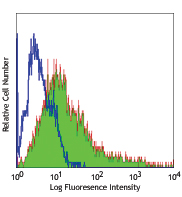
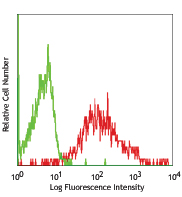
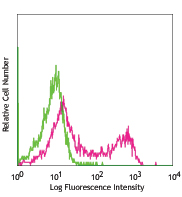
Compare Data Across All Formats
This data display is provided for general comparisons between formats.
Your actual data may vary due to variations in samples, target cells, instruments and their settings, staining conditions, and other factors.
If you need assistance with selecting the best format contact our expert technical support team.
-
PE anti-rat CD80
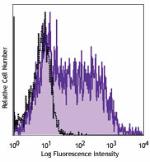
LPS-stimulated LOU rat splenocytes (3 days) were stained wit... -
Purified anti-rat CD80

LPS-stimulated LOU rat splenocytes (3 days) were stained wit...
 Login / Register
Login / Register 










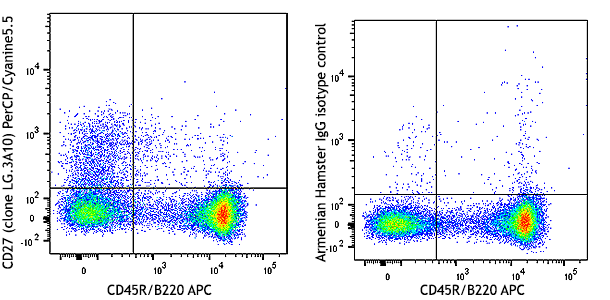



Follow Us